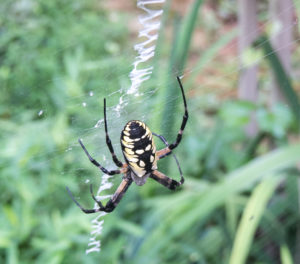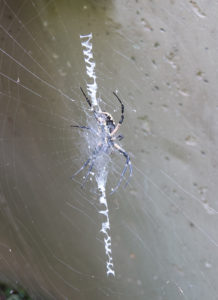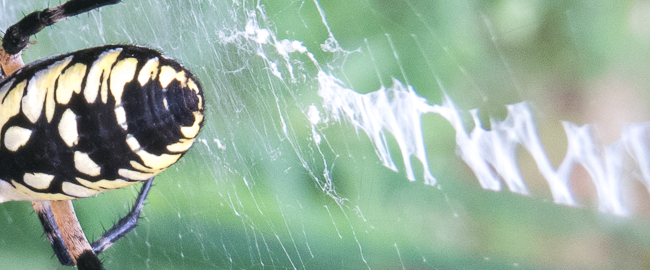Amanda wanted badly to tell me something about the house, but she’d only met me a few hours before. She didn’t know how I’d react.
She turned to her mom. “Should we tell her about… you know…”
Judy looked at her daughter, face frozen.
“The lady,” Amanda said. “You know. Out back.”
Judy said, “Sure.”
It’s our first day in the rental house. I’m thinking, Uh-oh. This is when I find out about the dead bodies in the garage that they didn’t mention in the lease.
Amanda still hesitated. “Well, this might sound really weird, but…”
I really do hope I’m wrong about the bodies.
Then her words came out in a rush.
“There’s this spider. She’s really big, but it’s OK, she’s not poisonous or harmful. She has bright colors and she’s amazing! She’s so beautiful, we don’t want to kill her.”
“Great!” I said. Phew! A big spider! Thank God.
Amanda still seemed a bit concerned that I would turn out to be a secret spider murderer, though. “So we hope that, you know…”
“Don’t worry,” I assured her. “I won’t kill her. People kill spiders and spray toxic chemicals around for no good reason, but most spiders are harmless and they are all helpful.”
“Yes!” Amanda said, “and they will eat insects that people also try to kill.” Yep. About 2,000 a year, according to one estimate.
She is a beauty.

This spider, I learned from a search, is Argiope aurantia, a “common” garden spider, though I’ve never run across one before.
It’s also called a writing spider or zipper spider because of the unique, ladder-like zigzag spun into the middle of its huge orb web.

The function of this ladder is unclear. Possibly it prevents birds from flying into the web and destroying a day’s work.
The female garden spider’s body can be an inch and a half long, up to three times the size of the male.
They mate in the fall. Then she eats him, lays her eggs, and dies soon after.
A pretty full life, for just one year.
An odd trait is that this spider may sometimes eat its own web every night and rebuild it the next day.
Our Lady of the Rental does not seem to be doing that. Most of the time she’s not moving.
I did observe her eating some prey that seemed to be still alive. It was so wrapped up that I couldn’t tell what it had originally been; I suppose it could have been her mate, even.
In this video I shot, you can see her sucking some liquid from it.
Today’s penny is a 2015, the year of the National Wildlife Federation’s latest mission statement, declaring the organization to be “dedicated to protecting wildlife and habitat.” Even spiders.
Their statement includes these tenets:
- We all have a right to enjoy sustainable and responsible outdoor recreation including: hunting, fishing, camping, birding, wildlife watching, hiking, climbing, swimming, boating, and gardening.
- Our nation must address climate change, continue moving toward cleaner energy sources, and make wildlife habitat and communities more resilient to such change.

this brought me back some great memories. We used to see these spiders a lot in our area (not so much in later years) and my father and I would ‘feed’ them. We would catch Japanese beetles (that we hated!) and gently toss them at the web. Miss Spider would race down and wrap them up for a later snack.
COOL!!!